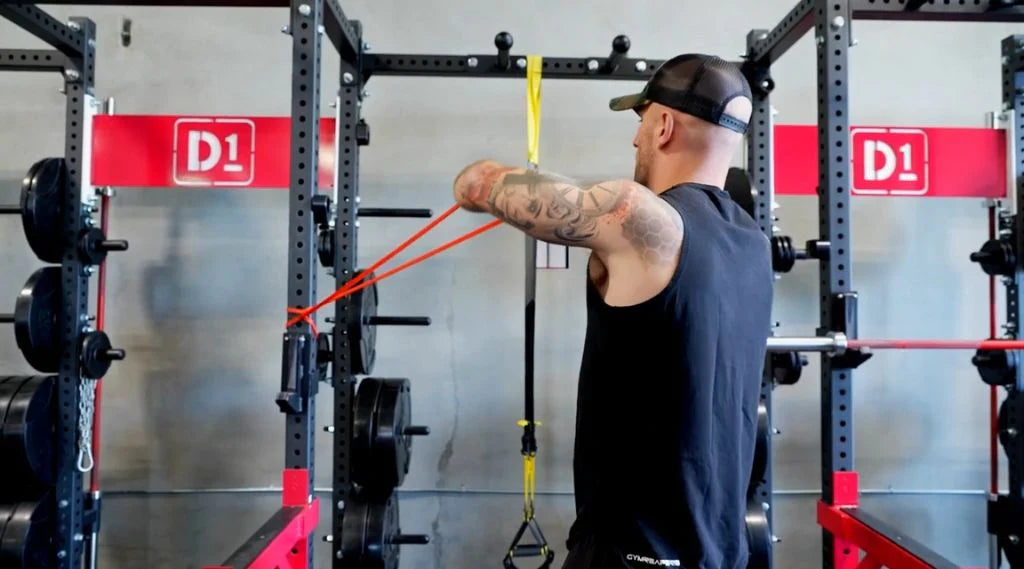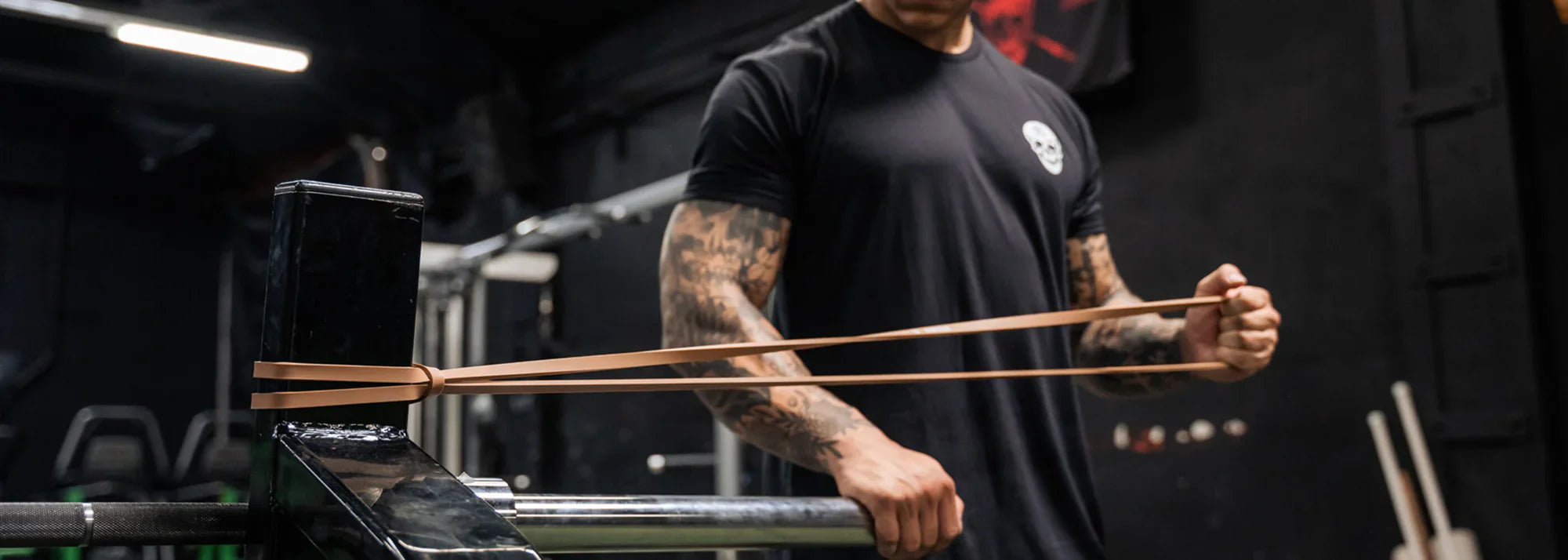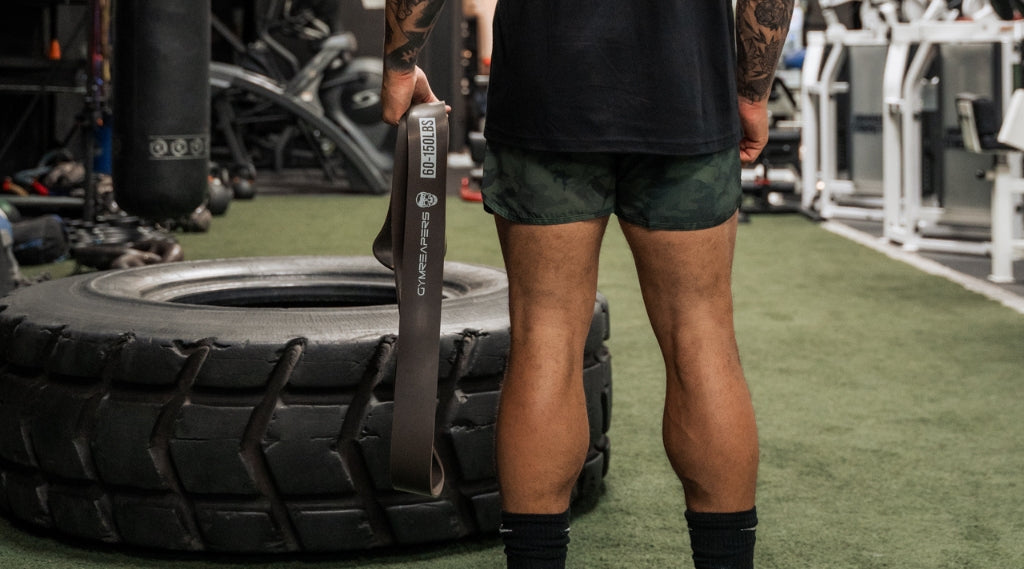If you’re training with limited equipment, trying to heal some shoulder pain and discomfort, or are sick and tired of dumbbell rear delt flies, banded face pulls are a great exercise that you need to try.
Banded face pulls are a phenomenal exercise for developing the muscles in your upper back and shoulder blades.
They can be implemented to improve your posture and shoulder stability or to stimulate muscle growth; however, they’re often performed incorrectly which minimizes their effectiveness.
To ensure you get the most out of your banded face pulls, I’ll teach you how to properly perform the movement with a step-by-step guide, highlight some common mistakes (and how to fix them), and discuss how you can implement them into your current routine to best support your goals.
Key Takeaways
Muscles Worked With Face Pulls

Face pulls are a great upper body exercise where the primary focus is to strengthen and build muscle in your upper back and rear shoulders, while also improving your posture and joint health.
When performed properly, face pulls engage the following 4 muscle groups:
Trapezius
Your “traps” are a large muscle in your upper back that gets heavily activated when performing this movement. They are a broad, triangular muscle that spans from the base of your skull to the middle of your back.
Since face pulls mainly work the upper back muscles near your shoulder blades, your traps are getting plenty of work in this movement.
Rear Delts
Your rear delts make up the back of your shoulders and are activated in the face pull to stabilize the shoulders by pulling them backward rather than letting them round forward.
This can be helpful long-term, as having strong rear delts can reduce your risk of developing shoulder injuries caused by too many pressing movements.
Rhomboids
Your rhomboids are the muscles that retract, elevate, and stabilize your scapula (shoulder blade). They are located in your upper back and are mainly targeted when you are retracting (squeezing together) and stabilizing your shoulder blades.
Having strong rhomboids is important for improving posture, preventing injuries, and increasing the pressing power in your chest and shoulders.
Rotator cuff
Your rotator cuff muscles surround the shoulder joint and help stabilize the arm in its socket. These muscles are not as visible as some of those mentioned above, so they are often neglected until they become a problem.
Face pulls are a great way to activate and strengthen these muscles to improve the overall stability and function of your shoulder joint.
How To Do Face Pulls With Bands: Step-By-Step Guide
Here are step-by-step instructions as to how to properly perform face pulls with a resistance band:
- Grab a looped resistance band. Choose a band that has enough resistance to challenge you, but not so much that you sacrifice your form and can’t control your movements.
- Set your band. Wrap the band around any stable anchor point (usually a pillar or squat rack) at face level. You can raise or lower your anchor point based on your preferred angles, but the default height should be at face level.
- Take your grip on the band. I recommend an overhand grip, making sure your hands are about 12 inches apart. If an overhand grip is uncomfortable on your shoulders, you can switch to a neutral grip where your palms are facing each other and your thumbs are pointed toward the ceiling.
- Step away from your anchor point. Stand far enough away that there is tension on the band even when you have your hands fully extended in front of you. Make sure that you are standing upright, facing the anchor point, and you have a very slight forward lean.
- Slowly pull your hands towards you. When pulling the band towards you, make sure you first start the movement by retracting your shoulders and then following with your elbows. Keep your upper arm parallel to the floor.
- Rotate your arm externally. As you pull, rotate your arm so that the back of your hand is pointing behind you. You should end up in a stance that looks like a front double bicep bodybuilding pose, making sure that your shoulder blades are still retracted.
-
Return to the starting position. Slowly release the band tension and resume your start position. Let your shoulders get pulled forward, and then start another rep.
Common Face Pull Mistakes With Bands
Here are the 3 most common mistakes that I see lifters make with banded face pulls:
Mistake #1: Using Too Much Momentum
The first mistake that I see very frequently with banded face pulls is using too much momentum. By this, I mean letting your upper body rock back and forth with the band to try and force extra reps or letting your biceps take over instead of focusing on performing the movement with your upper back.
People may make this mistake for a variety of reasons, but the most common mistakes are: the band tension is too heavy, they have not been taught proper technique, or they are trying to squeeze out extra reps that they cannot actually perform properly.
I understand these reasons, but this is a fairly critical mistake. Face pulls are meant to be performed strictly so that the smaller and often under-developed muscles in your upper back and shoulder blades can be targeted properly.
If you become lazy with your technique, you will reduce the muscle activation of the areas you are actually trying to train, and you may increase your risk of injury by moving in an uncontrolled manner.
How to Fix Face Pull Mistakes
To fix this mistake, you should first be aware of the proper technique.
With this in mind, you need to make sure that your feet stay planted on the floor throughout the entire set, and you do not allow your body to create momentum by rocking back and forth with the face pulls.
Instead, be sure to brace your core and lock your torso in place, so that you can only move the band as desired by retracting your scapula and recruiting the proper muscles.
If you are being mindful of the exercise and whether or not you are actually feeling a squeeze in the right muscles, you should have solved this problem. If not, you might need to lower the resistance band tension by grabbing a lighter band or standing closer to your anchor point.
Mistake #2: Using Too Much Weight
This mistake goes hand in hand with using too much momentum.
It's pretty common for lifters to select a band that’s tension weight that is just too heavy for this exercise. Remember, you are training your rear delts, traps, and rotator cuff muscles. You are NOT performing a high row, where you’re looking for your lats and biceps to take over.
The rear delts are a smaller muscle group, and if you're not used to working them, you will need to go lighter than you would with other shoulder exercises.
How to Fix Using Too Much Weight
If you find you're using momentum to pull the attachment toward your body, if you can't control the weight as it returns to the stack, or if the resistance is pulling your body forward, then you should probably reduce the amount of weight you're trying to lift.
To target the rear delts effectively, you need to make sure you're not inadvertently recruiting additional muscle groups to take over to perform the exercise.
Mistake #3: Allowing the Band To Go Slack
Another common mistake is not keeping the resistance band taut as the exercise is performed, which reduces the resistance and decreases the effectiveness of the training.
One of the main benefits of banded training is that your muscles are actively engaged throughout the entire range of motion of an exercise, regardless of what position they are in or the forces of gravity. If you allow your band to go slack, you are robbing your muscles of that benefit.
On top of that, if you start your pull with slack in the band then you may increase your risk of injury when the band tightens suddenly.
How to Fix Allowing the Band To Go Slack
This is a simple problem to fix. You simply need to stand far enough away from your anchor point to ensure the band is taught before you initiate the face pull and remain taut between every repetition.
Implementing Banded Face Pulls Into Your Training Routine
The best ways to implement banded face pulls into your training routine will vary based on your goals. However, I'll outline the two most common use cases for implementing this exercise, and explain the ideal sets and reps schemes for both.
Building Stability
If you are looking to implement banded face pulls to increase your shoulder stability, you should start by performing 2-4 sets of 10-15 reps.
If stability is your main goal, you should be focused on perfecting your form and controlling the entire movement using a lighter band. Focusing on retracting your scapula and activating your rotator cuff muscles will pay huge dividends.
I perform at least 2 sets of 15 banded face pulls before every single training session where I will be performing a push movement. I find this to be a great way to warm up my shoulders, and have noticed significantly less pain and discomfort.
Hypertrophy
If your main goal with banded face pulls is to encourage muscle growth in the targeted muscles, you’ll want to implement more volume and intensity into your face pull training.
I recommend performing 3 sets of 15-20 reps with one minute of rest in between each set. Then, you could also add a fourth and final AMRAP (as many reps as possible) set after another break.
When performing these sets, I focus on keeping a controlled tempo, limiting momentum, and focusing on the target muscle areas to ensure I’m maximizing muscle activation.
Best Bands For Face Pulls
If you’re looking to purchase bands for face pulls, I highly recommend getting a set of multiple bands. This will provide you with varying levels of resistance to choose from and will help you get the best gains long-term.

The military resistance band set by Gymreapers is a great set of bands for stability, strength, and muscle growth because they come in a variety of resistance levels. They work for face pulls and many other banded exercises, making them ideal for training multiple muscle groups. You can pick from several tension levels to match your abilities:
- Desert Tan - 20 to 35 lbs.
- OD Green - 30 to 60 lbs.
- Dark Earth - 40 to 80 lbs.
- Ranger Green - 50 to 120 lbs.
- Coyote Brown - 60 to 150 lbs.
In my opinion, the best bands for face pull variations will be the Desert Tan or the OD Green. The other bands will likely be too heavy for face pulls and will probably lead to the common mistakes we discussed, so it’s best to save those for other banded exercises.













Leave a comment
All comments are moderated before being published.
This site is protected by hCaptcha and the hCaptcha Privacy Policy and Terms of Service apply.